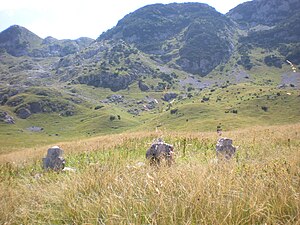 Global Information
Global InformationOperation Trio information
| Operation Trio | ||||||||
|---|---|---|---|---|---|---|---|---|
| Part of World War II in Yugoslavia | ||||||||
 Tito and the main force of the Partisans withdrew into the Zelengora ("green mountain") mountains to escape the Axis offensive | ||||||||
| ||||||||
| Belligerents | ||||||||
|
|
| ||||||
| Commanders and leaders | ||||||||
|
|
| ||||||
| Units involved | ||||||||
| Unknown |
| ||||||
| Strength | ||||||||
| around 4,000 men[2] | ||||||||
| Casualties and losses | ||||||||
|
15 wounded 1 missing 556 wounded 173 missing 149 wounded 121 missing[3] |
74 killed 102 wounded 3 missing[3] |
1,646 killed 719 wounded 2,626 captured (259 executed)[3] many defected to Chetniks | ||||||
Operation Trio (Serbo-Croatian Latin: Operacija Trio) was the first large-scale joint German-Italian counter-insurgency operation of World War II conducted in the Independent State of Croatia (NDH), which included modern-day Bosnia and Herzegovina. It was carried out in two phases within eastern Bosnia from 20 April to 13 May 1942, with Ustaše militia and Croatian Home Guard forces taking part on the Axis side. The aim of the operation was to target all insurgents between Sarajevo and the Drina river in eastern Bosnia. These included the communist-led Yugoslav Partisans and Serb nationalist Chetniks. Differentiating between the rank and file of the two insurgent factions was difficult, as even the communist-led insurgent groups consisted mainly of Serb peasants who had little understanding of the political aims of their leaders.
Operation Trio consisted of two parts, Trio I and Trio II. Together they comprised one element of the Axis effort known as the Third Enemy Offensive (Serbo-Croatian Latin: Treća neprijateljska ofenziva) in post-war Yugoslav historiography. The joint Italian-Chetnik offensive in Montenegro and eastern Herzegovina formed the other element. The Third Enemy Offensive forms part of the Seven Enemy Offensives framework in Yugoslav historiography.
The operation was of limited effectiveness due to several factors, including preemptive action by the Ustaše militia and Italian delays. The area of operations straddled the demarcation line between the German and Italian zones of occupation within the NDH, which led to mutual suspicion and lack of coordination. Both insurgent factions avoided fighting the Axis and NDH forces, instead focusing on fighting each other. After Operation Trio, the Partisan leader Josip Broz Tito, his Supreme Headquarters and the Partisan main force, consisting of the 1st and 2nd proletarian brigades, withdrew from their base of operations around Foča. After briefly reorganising around Zelengora mountain south-east of Foča, they moved their operations to western Bosnia for the remainder of 1942.
Operation Trio coincided with and contributed to the polarisation of the almost exclusively Serb rebels in eastern Bosnia into two groups: the Serb-chauvinist Chetniks and the multi-ethnic and communist-led Partisans. Encouraged by Chetnik propaganda against Croats and Bosnian Muslims and repelled by the sectarian left-wing policies and actions of the communists, many Serb peasant fighters were swayed to the Chetnik cause. Violent coups occurred against the communist leadership of all but one of the Partisan detachments in eastern Bosnia, and these detachments effectively defected to the Chetniks. Most of the surviving communist fighters from these detachments rejoined the Partisan forces, and many withdrew with Tito to western Bosnia during the Partisan Long March. Within a few weeks of the end of Operation Trio only 600 Partisan fighters were left in eastern Bosnia, comprising the Group of Shock Battalions and the Birač Partisan Detachment. All these forces sought refuge in the Birač region. The Chetnik movement in eastern Bosnia, at best a confederacy of local warlords, was strengthened by mass defections from the Partisans. For a time they ruled large parts of the region, after making accommodations with the Ustaše regime in May and June 1942.
- ^ Rodogno 2006, p. 310.
- ^ Milazzo 1975, p. 69.
- ^ a b c Rodogno 2006, p. 442.